In the first article, I’ve given you an overview of Lithium-Ion batteries and cells as building blocks for our projects, and described how hackers should treat their Lithium-Ion cells. But what if you don’t have any LiIon cells yet? Where do you get LiIon cells for your project?
Taking laptop batteries apart, whether the regular 18650 or the modern pouch cell-based ones, remains a good avenue – many hackers take this road and the topic is extensively covered by a number of people. However, a 18650 cell might not fit your project size-wise, and thin batteries haven’t quite flooded the market yet. Let’s see what your options are beyond laptops.
Smartphone Batteries A Viable Source
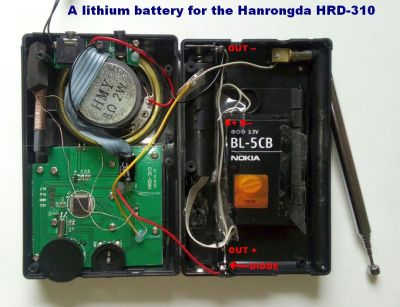
First underappreciated source of LiIon cells, specifically pouch cells, are smartphone batteries. Of course, we’ve all seen a phone battery die earlier than the phone did, and in many modern phones, the cell is glued-in and harder to extract. However, shopping for smartphone batteries in your local stores is still worthwhile if you need a small cell to power your device.
For instance, user-replaceable batteries are still manufactured and sold for numpad phones from manufacturers like Nokia, with cells typically around 1000 mAh, more than enough for a small ESP32 or Pi Pico project that spends lots of time asleep. If you’d like to make your device repeatable by others and make battery sourcing simple, perhaps work around LiIon shipping restrictions, or if you’re a garage startup itching to get a small prototype batch out of the door, smartphone batteries are a good bet.
Even more, there’s not much preventing you from putting the same contacts used by phones onto your PCB. You can source these contacts from online repair shops, LCSC, Aliexpress and probably more. With a smartphone cell, you get a protection circuit, usually a built-in thermistor and often a one-wire or I2C fuel gauge. Most importantly, you get a battery with an active supply chain, which means you can design it into your project mechanically and electrically, and not fear a redesign a few months in when all local stock of a very specific cell suddenly runs out. One small thing to keep in mind – while older Nokia batteries have a third pin, it’s not a thermistor pin – instead, it’s a fixed-value cell identification resistor.
 We’ve seen this done with iPhone batteries, and we’ve also seen things like makeshift pin header-based holders for smartphone cells. I first encountered it when I saw pictures of a Chinese radio using Nokia format batteries, and I’ve been designing them into small-scale stuff ever since. You don’t have to look for “genuine” cells, third-party cells with good reviews are a decent source and tend to provide more value per dollar, but bottom-of-the-barrel cells are likely to disappoint.
We’ve seen this done with iPhone batteries, and we’ve also seen things like makeshift pin header-based holders for smartphone cells. I first encountered it when I saw pictures of a Chinese radio using Nokia format batteries, and I’ve been designing them into small-scale stuff ever since. You don’t have to look for “genuine” cells, third-party cells with good reviews are a decent source and tend to provide more value per dollar, but bottom-of-the-barrel cells are likely to disappoint.
Vaping has helped make LiIon cells a bit more accessible. First off, disposable vapes provide us with small cells that are nicely reusable – remember to use protection. However, vape shops are also a decent source of high-current-capable 18650 cells, and if you’re a hobbyist designing a device with an 18650 holder in it, you don’t have to worry about battery shipping restrictions unfairly impacting small-scale producers when you can ask your recipient to go to a vape shop and buy a 18650 for a modest markup.
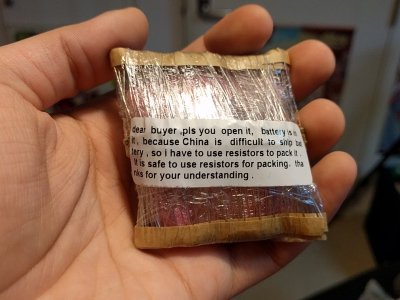 There are also specialized stores that sell LiIon cells and batteries, 18650 and pouch alike, with good prices and inexpensive ground shipping. Quad and other remote-controlled vehicles eat them up, so a shop like Hobby King often has good deals. In Europe, Nkon is one of the go-tos, and I’ve had great success getting 3.5 Ah cells from there with prices comparable to Aliexpress fake “6.5 Ah cell” listings. Speaking of that, I can’t say I recommend Aliexpress – to this day, they seem to need to resort for tricks when airmailing you cells, which sometimes still get randomly seized by customs screening, and cells of subpar quality have a non-negligible market share there.
There are also specialized stores that sell LiIon cells and batteries, 18650 and pouch alike, with good prices and inexpensive ground shipping. Quad and other remote-controlled vehicles eat them up, so a shop like Hobby King often has good deals. In Europe, Nkon is one of the go-tos, and I’ve had great success getting 3.5 Ah cells from there with prices comparable to Aliexpress fake “6.5 Ah cell” listings. Speaking of that, I can’t say I recommend Aliexpress – to this day, they seem to need to resort for tricks when airmailing you cells, which sometimes still get randomly seized by customs screening, and cells of subpar quality have a non-negligible market share there.
Mind The Mechanics
Once you got hold of some cells, how do you connect them into your circuit? If they’re 18650s, it’s good to have a holder – Thingiverse has no shortage of printable ones, and commercially made holders tend to be less frustrating to use. Leaf contact holders are better than spring-based ones when it comes to higher-current applications; otherwise, you might never notice a difference. In a pinch, if you have four disk magnets, you can clamp two wires between two magnet and snap them onto your 18650s for a holder – I’ve done that for a hackathon once, when we badly needed to power a Raspberry Pi 3 inside a wearable device and there was no a suitable powerbank around.
With a pouch cell, if it has wires that terminate in a plug, it’s good to have a receptacle for it – desolder it from the original device if needed. Otherwise, you can fashion a plug out of pin headers, even if it’s going to be non-polarized – you’ll want to add your own polarity mechanism, i.e. color-coding. Remember, female header on the power source, male header on the power input – shorting the battery is worse than shorting a non-connected power input by accident.
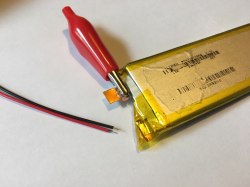 If your pouch cell doesn’t have a connector and just has tabs, you’ll want to solder to those tabs – but a good practice is that you clamp a crocodile clip between the solder point and the battery before soldering, for heatsinking purposes. These tabs are wired up directly to the polymer layers inside the cell, and overheating that might shorten the battery life.
If your pouch cell doesn’t have a connector and just has tabs, you’ll want to solder to those tabs – but a good practice is that you clamp a crocodile clip between the solder point and the battery before soldering, for heatsinking purposes. These tabs are wired up directly to the polymer layers inside the cell, and overheating that might shorten the battery life.
You’ll also want to make sure that pouch cells are not at risk of being punctured or squished, and that this doesn’t happen if the cell starts to puff up, either. This means not gluing it to the bottom of your board if you also have through-hole pins sticking out on that side, for a start. Having a 3D-printed holder with at least one wall being bendy and thin (if not open) will be helpful – and make sure that the cell doesn’t end up being stuck inside this holder in the not-unlikely case that it decides to puff up. Smartphone batteries of the swappable kind tend to be a bit sturdier, but you still would benefit from extra mechanical protection.
Standardized Connector, But Not Quite
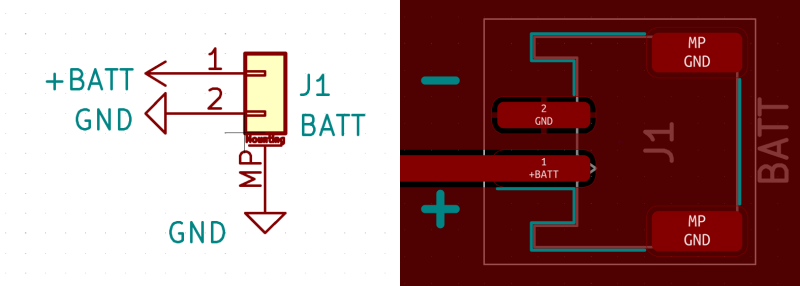
A good connector for LiIon pouch cells is a two-pin JST-PH – it’s the one you will see most often on random boards out in the wild, and therefore the one that it makes sense you stock up on connectors and cables for. When it comes to the PCB side connectors, you should get the SMD version, JST part number being S2B-PH-SM4-TB and alternatives searchable using “1x2P PH 2mm”. Sadly, the through-hole version of this connector is flimsy, lacking shell mounting pins – the metal pins break off relatively quickly, whereas the SMD version is quite sturdy and stays on the board.
As you get into the groove of adding battery power to your projects, it will help a lot if you stock up on some JST-PH leads in advance, from places like Adafruit, Aliexpress or other stores – I got a 50-pack from the Lilygo store. Crimping your own, while technically possible, might result in wires that pull out of the crimp easily, which is a giant pain and tends to happen at the most inopportune moment. We’ve covered the subject of crimping extensively; the gist is, if you don’t have access to a proper crimping tool, it’s way better to buy a bouquet of pre-crimped wires. When unplugging a JST-PH connector, it’s best to grab it by its wings with flush cutters or tin snips.
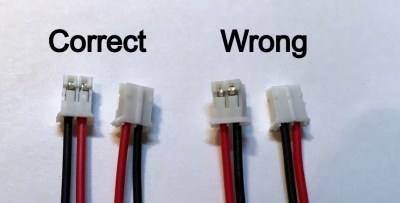 Careful – even though JST-PH connectors are used on boards from a large variety of different hobbyist manufacturers, there are two different pinouts for JST-PH 2-pin battery plugs. Places like Adafruit, Sparkfun, HobbyKing and others use a pinout where the positive (red) is pin 1 and negative (black) is pin 2, whereas many Chinese sellers have it the other way around – negative being pin 1 and positive being pin 2. This divide, thankfully, doesn’t extend to microcontroller boards – Wemos and Lolin boards seem to use the same pinout as Adafruit and Sparkfun.
Careful – even though JST-PH connectors are used on boards from a large variety of different hobbyist manufacturers, there are two different pinouts for JST-PH 2-pin battery plugs. Places like Adafruit, Sparkfun, HobbyKing and others use a pinout where the positive (red) is pin 1 and negative (black) is pin 2, whereas many Chinese sellers have it the other way around – negative being pin 1 and positive being pin 2. This divide, thankfully, doesn’t extend to microcontroller boards – Wemos and Lolin boards seem to use the same pinout as Adafruit and Sparkfun.
Plugging a battery in reverse is basically guaranteed to kill your board – to be exact, at least its power management components. With JST-PH 2-pin, this means you should always check your pinouts. If you design your own board, you should place pinout markings on the silkscreen next to the connector – a practice that more PCB designers ought to adhere to when they add JST-PH battery connectors to their boards. Thankfully, you can easily rewire JST-PH plugs to whichever standard you desire to stick with – and take care not to short-circuit the cell as you pull its contacts out of their shell while rewiring the plug.
Taking Flight
If you carry a battery-powered DIY device, going to an airport might sound intimidating, yet it’s more viable than it might sound – if you want to take your device with you as you embark on a flight, you can. Keep in mind – LiIon cells and devices with LiIon batteries in them have to be in your carry-on, and they’ll have to go through the security scanners just like your laptop and phone. Making your device more presentable to some extent will help, and keeping the batteries separate from the device is a great idea if you want your airport security queue experience to be seamless. Again, both pouch cells and 18650s are best stored in some kind of hard case when transporting them. With a bit of presentability and precautions combined, your creations can travel with you.
Next time, let’s talk about the electronics nitty-gritty – charging cells in 1s configuration, converting LiIon voltage to more friendly 3.3 V, protection and power paths, with ready-to-use examples you can put on your boards.

















Other sources for cells/packs:
Power tool batteries
USB phone charger batteries (can find at discount stores)
Rechargeable flashlights
Yes, tool batteries – the Tool Bear at YouTube’s Den of Tools did a teardown of Harbor Freight’s Hercules “20V” 12Ah battery to find top-notch Samsung cells, I think 21700’s, 35A continuous, 4000mAh, 3P5S for 15 cells. Now on sale for $120. 18650batterystore sells those in bulk for as little as $4.15 if you buy 1000+ but the Hercules pack gives you BMS and protection and can produce about 1800 Watts unless the BMS limits it – 3x35A @ 18V nominal if allowed its full potential.
that’s a bit rich for my blood – you can get the “Bauer 20v” standard size for $25, and a 2x2A USB adapter for $18 (caution! has a high standby drain).
Disposeable vapes, how could you forget those perfectly good & free 400mAh pouches?
No, you didn’t
I remember reading somewhere (amybe even here) that vape batteries may have not passed quality control and because of this end up going into a single use item. Does anyone know if there’s any truth to this? It sounds unlikely in the “churn ’em out as cheap as possible” economy that they’re tested at all.
I highly doubt it. Having visited a battery factory in china – their limiting factor for quantity manufactured was the electricity connection for the campus to bring them up to storage/shipping voltage. The process was highly devoid of humans in a clean room environment and everything outgoing was tested by automated testing line (internal resistance?).
Yeah, you went to a different Chinese battery factory than I did. Everything was manual in the supplier I visited. In fact, it’s hard to imagine how a manufacturer in China could ever make heavy automation pay off with low labor rates.
The labor rates are not low anymore. Those times are long gone.
QA is more cost-effective than you might expect.. it basically goes back to the management principles of W. Edwards Deming:
– Rework costs money
– Scrap costs materials and embodied work
– Testing to identify units for rework or scrapping costs money
– Flaws that lead to rework or scrapping happen for reasons
– Identifying and controlling the reasons for flaws is cost effective
Today almost all bulk production revolves around the idea of a controlled process: a system that generates product meeting the criteria to be sold 99.9+% of the time. Instead of testing units individually, you test parameters and small samples that show the system is reliably producing product that falls within the specified tolerances.
The buzz-phrase is ‘six sigma’, which means keeping the tolerance of the process 1/6th the sales tolerance: to make 5% resistors, you want a process whose standard deviation is 0.83%. Statistically, the chance of such a system producing a resistor more than 5% away from its nominal value is about 1 in 500 million.
That -is- the “churn ’em out as cheap as possible” process. The “do sloppy work and don’t test anything” process leads to customers seeing lots of failures and suing for damages.
Cutting corners with controlled processes usually means accepting wider tolerances. For things like single-use vaping batteries you can widen the tolerance for things that lead to accelerated aging, worse thermal stability, and so on. As long as consumers don’t call the battery defective by the time it stops being useful, the battery is acceptable for that market.
Even by those terms, the process-related variability is far smaller than the amount of uncertainty you’re going to accept from scavenged batteries. If you don’t know how many times a battery has been recharged or what operating conditions it’s seen, you have no idea what to expect from it.
China.
The question is what do they do with those batches that don’t pass QA. There’s always some. The Chinese also tend to pass a certain percentage of bad stock through to the customers anyways. If there’s a known bad batch, instead of throwing it away they may dilute it into the good batches. It’s a game of “it’s only wrong if you catch me doing it.” and “You didn’t tell me not to.”
The point of the statistical testing is that the deviations follow a normal distribution, so even the outliers are somewhat the correct value or property. Dropping in known faulty parts is a rotten apple in the barrel – you can expect the outlier to be anything.
Depends how many vehicles have run over it once it has been “disposed of”.
I’ve already got a few of those :D
Thoughts I’ve been having…
Sometimes turning up cheap are LIon packs for specific cameras and other devices, replacement cells, cheap, new and sealed, at surplus outlets. Typically they have the 3 pad contact. Many cellphone batteries are like this also. Then there have been a lot of magnetic and low insertion force custom charger cords around that have some kind of end, with 3 sprung contacts. If you chop back some of the housing/shell on those you can either put them in a rigid case that fits specific battery, so the battery depresses the contacts. OR you can go for an “any cell I can get” type of setup where you might be able to swap in several different 3.7V cells from phones and cameras etc, if you use one of the cheap cellphone holders that are variable width and sprung. Build the sprung contact into one of the arms. Be aware you still need to have rewired the connector to charging/supple circuitry, don’t just plug it into USB or whatever as it came. I’d also recommend great care in marking up your cells and charger for polarity in case you get any that are ass backwards, and pay attention when you connect, since you haven’t got a mechanical lockout to stop you putting them in wrong. Grab the next bottle of red nailpolish your wife/girlfriend is chucking out and red dot the pos sides. (I also red ring all my center negative, outer positive power sockets, ‘coz center pos got common enough you forget to check.)
A source for small packs seems to be cheap/novelty bluetooth speakers, that either turn up in surplus dirt cheap new, or are discarded through thrift stores and yard sales for cheap or free. Or they can be got free sometimes as promotional items.
Pin 1 negative.
– Because negative is the lowest voltage and pin 1 is the lowest pin
– Because there’s only one negative, while there may be multiple positive voltages from a pack
Looking at a molex connector (hdd and floppy) on a pc would prove both those statements wrong.
At this point, you have to contend with a myriad of hobbyist-aimed cells crimped with JST-PH connectors, and have them change somehow – which would be a pain. Plus, this standard is for 1s packs and cells only, I don’t see how adding compatibility to 2s and beyond would offset the problems caused by diverging from a commonly accepted standard.
At least with JST-PH you can change the pins around decently easily.
I usually carefully pull up the tab locking the contact in place with a small screwdriver or thin forceps and pull the contact out.
Makes changing the pinout a breeze.
oh absolutely! I linked a small video tutorial to that in the text, too!
I’d take the accepted standard over nonstandard logical reasoning. The legacy stuff is probably not going away so any change just adds to the problem.
Probably get pushback on this because it doesn’t agree with some peoples gut feelers, but, if you’re soldering something heat sensitive, such that you need a heatsink, or if you’re soldering something that can itself sink a lot of heat, use a higher powered iron. What you need to do is get heat into the solder join faster than the heatsink can remove it. If you do not do that, you cannot solder until the heatsink, and typically the entire workpiece has heated itself slowly up to flow temperature, which is what you are trying to avoid. You wanna use the heatsink, apply high powered iron, BAM done, not be sitting there 5+ minutes warming everything up with a 15W.
For pouch batteries I’ve noticed that usually anode material differs from cathode material. One of those tabs easily wicks solder with standard flux – the other basically doesn’t or when it seems like it has done so – it is purely out of surface unevenness making a symbolical mechanical joint that may fail prematurely, even moreso if used in a high vibration environment (think ebike).
The above is absolutely correct. I use a stained glass soldering iron with a giant tip.
Also, if you’re super paranoid you can spot weld a little piece of nickle strip to each contact and solder to that.
If you own a spot welder, why would you solder cells at all?
You have the right tool for the job.
No BAM please!
I believe you are right. I always crank my iron up for battery tabs
Yep. A higher wattage iron with a fat chisel tip. Not your pcb iron. It’s all about heat transfer and having enough dwell time to properly heat the cable while being short enough not to damage the pack. I have seen WAY too many poor joints from “professional” shops on 6S 12000mA packs and power input harnesses. Scabs. No flow. Not enough solder in the joint.
As I’ve posted before, it is very difficult to get decent pouch batteries in Aus – the ones (many) I’ve tried fail at about 100 charges – and the problem with phone batteries are they are often too big!.
I recently did ‘dremel’ out an electronics product to take a nokia battery, but sometimes that isn’t doable…
Not everything can take a 18650 (which I agree you can get decent ones of if you are careful enough) – but I’ve yet to find a reasonable quality pouch battery that can be shipped to Aus. Suggestions welcome!
Excellent practical article, thank you. This is why I come here.
Probably nitpicking, but LiIon reads like LiLon for me with the font that HAD uses. So i prefer Li-ion for easier reading.
hmm ahha, that makes sense, I will look into changing that – thank you for noting!
I have a similar problem with “Artificial Intelligence Williams”!
“user-replaceable batteries are still manufactured and sold for numpad phones from manufacturers like Nokia”
In my experience, with the exception of supposedly OEM (but I doubt it) cells which are very expensive and, therefore, I haven’t bought, those have been fraudulent, counterfeit junk. Even those sort of packs in Chinese handheld game systems have in my experience greatly degraded in short order meaning that even OEMs are getting that junk in their supply chain and being typical, zero business ethics Chinese businesses, they don’t give a damn.
The 18650 market has been totally polluted with counterfeit Chinese junk with even cells purchased from retailers specializing in batteries having only a portion of their rated capacity in my experience. No cell I’ve ever bought from eBay or Amazon has ever been more than 50% of its claimed capacity and I don’t buy cells with obviously ridiculous, impossible capacity claims. So, I can see why people open up laptop battery packs.
On t he other hand, I’ve found Hobby King to be a reliable source for reasonably priced, quality lipos.
Yeah like, I absolutely wouldn’t put a lot of hope into a Chinese handheld game console batteries, not suggesting that either. It seems there’s ‘third-party but reliable’ manufacturers for phone batteries – can’t name names off the top of my head, but they’re def there. IMO when we get counterfeits from retailers specializing in batteries, we ought to apply pressure, because we aren’t getting more reliable than that otherwise. eBay and Amazon, I’d rather not touch altogether, and don’t know if we benefit from seriously considering them as ‘18650 market’. Nkon, I’ve had great experiences with, and HobbyKing, I’ve seen others have good experiences with.
The problem is the OEMs are doing this deliberately as a measure of planned obsolescence. A phone manufacturer will simply change the format slightly and stop supplying the genuine batteries, so the customers AND retailers are left alone trying to source 3rd party parts from the market that is full of counterfeits.
The retailers have no means, intent, or the money to test for counterfeits. They can only buy some and then get a bunch of complaints form customers, then pull that product off the shelf and try again with a different source that is equally likely to be fake. Rinse and repeat.
I would like to add here that at airport the security also checks for the device in which the battery is being used. I mean the associated device should also be carried along with the battery. Once I was carrying solar cells for my home to replace the old ones but they didn’t allow as I was not carrying the garden lights.
That sounds quite security-specific – everywhere I’ve seen, you could absolutely carry spare batteries without the device specifically – i.e. carrying a bunch of 18650s. For those, you can say they’re for your vape, which is currently in your checked-in luggage, because vape liquids. Sadly, if a specific security agent says something is not allowed, not much you can do except argue, and some of them are known for inventing things on the spot. That said.. Solar cells? o_o
Stick your hand in the recycle bin at home Depot or target. Don’t ask. Ignore the yelling wear a mask. Recycling is a deviant act in our society.
+++++10
I used to get away with this often. I would at times back in the day receive permission from some employees. I would get the old packs and it would usually just be one offending cell. I would rebuild my own power tool packs as well as my coworkers.
This is a big no-no nowadays. Most of those recycle bins are secured with locks and they now consider such dumpster diving inside the front of the store as theft. Same as shoplifting. Once a consumer properly disposes of the battery at one of the collection bins, it is considered property of the recycle company contracted to provide those bins.
I have seen similar things at some of these recycle electronics public events hosted in shopping center parking lots. They get a company out there in a U-Haul or similar box truck to hang out all day under a banner and they take in people’s discarded electronics.
On a couple of occasions I have seen some vintage vacuum tube driven audio pieces discarded and no amount of begging, pleading or bribery could save the equipment from being tossed into the back area of a box van with complete disregard.
I managed to once bribe a cool old Valco guitar amp for a twelve pack.
But lots of perfectly working and serviceable electronics get discarded this way. Often seen are fairly late model laptops that only need be reloaded with new operating systems .
Some recycler companies will refurbish but the majority will simply send stuff thru the shredder to mine the precious metals.
Getting batteries from the bins at Home Depot is no longer a option .
The bins are now secure and not just some cardboard box. Helping yourself
is not a good thing here and it can actually get you into trouble, maybe even arrested! As stupid as that sounds!
Powerbanks! So often they are just discarded because of a bad USB solder (or one bad cell) – I think I’ve bought at least 10 in the past 5 years. Loaded with 18650s or pouch cells. Also – Dyson vacs (any rechargeable tool really) are notorious for failing cells, when in fact perhaps just one of the 18650s might be a little out of spec. Powers one of my projects just fine!
Exactly power banks. And maybe for some projects to use it as is. Integrated USB charging circuit, usually basic level indicator and 5V out.
If you want a simple polar connector use three in-line pins – both outers ALWAYS negative, inner positive. Reversing it doesn’t reverse the polarity.